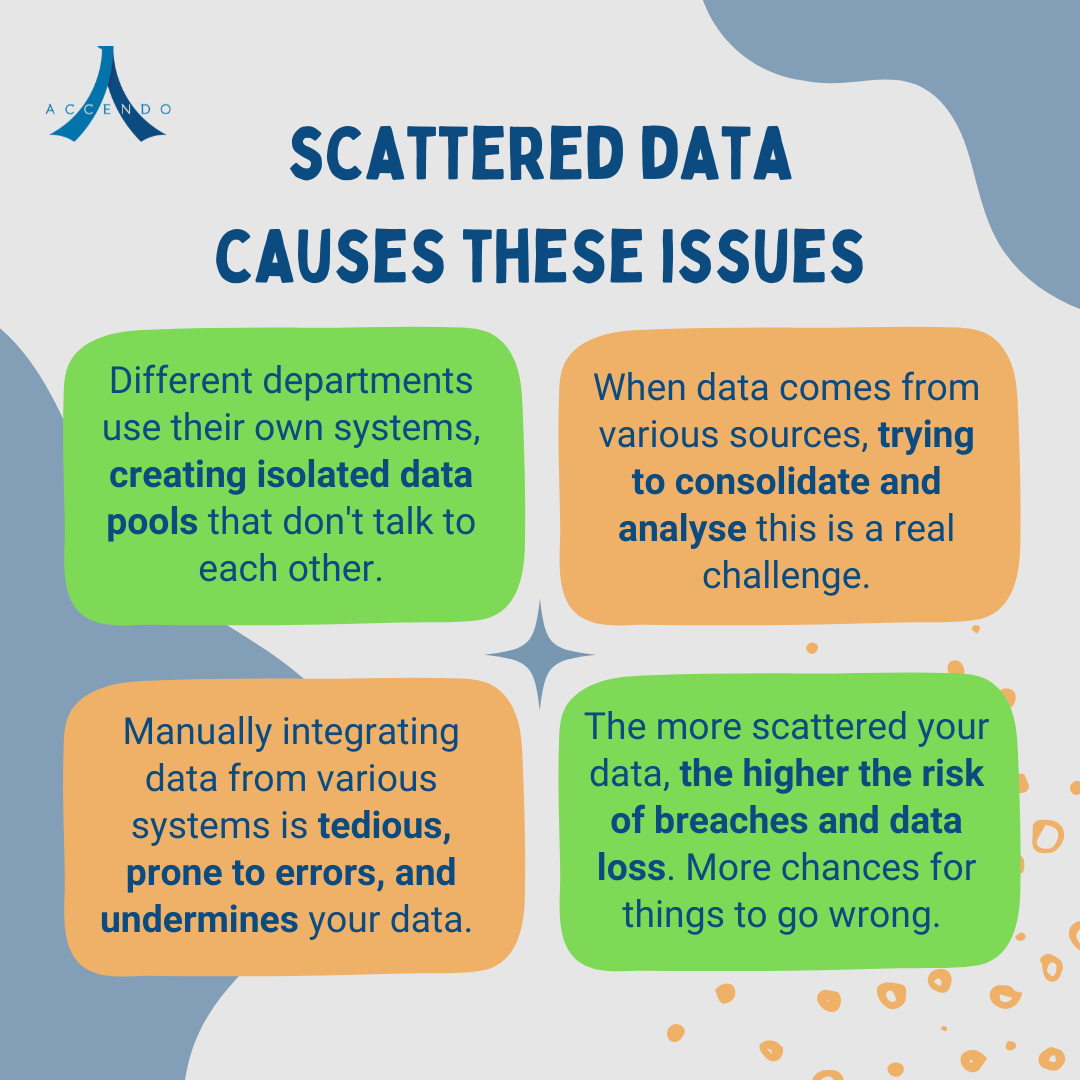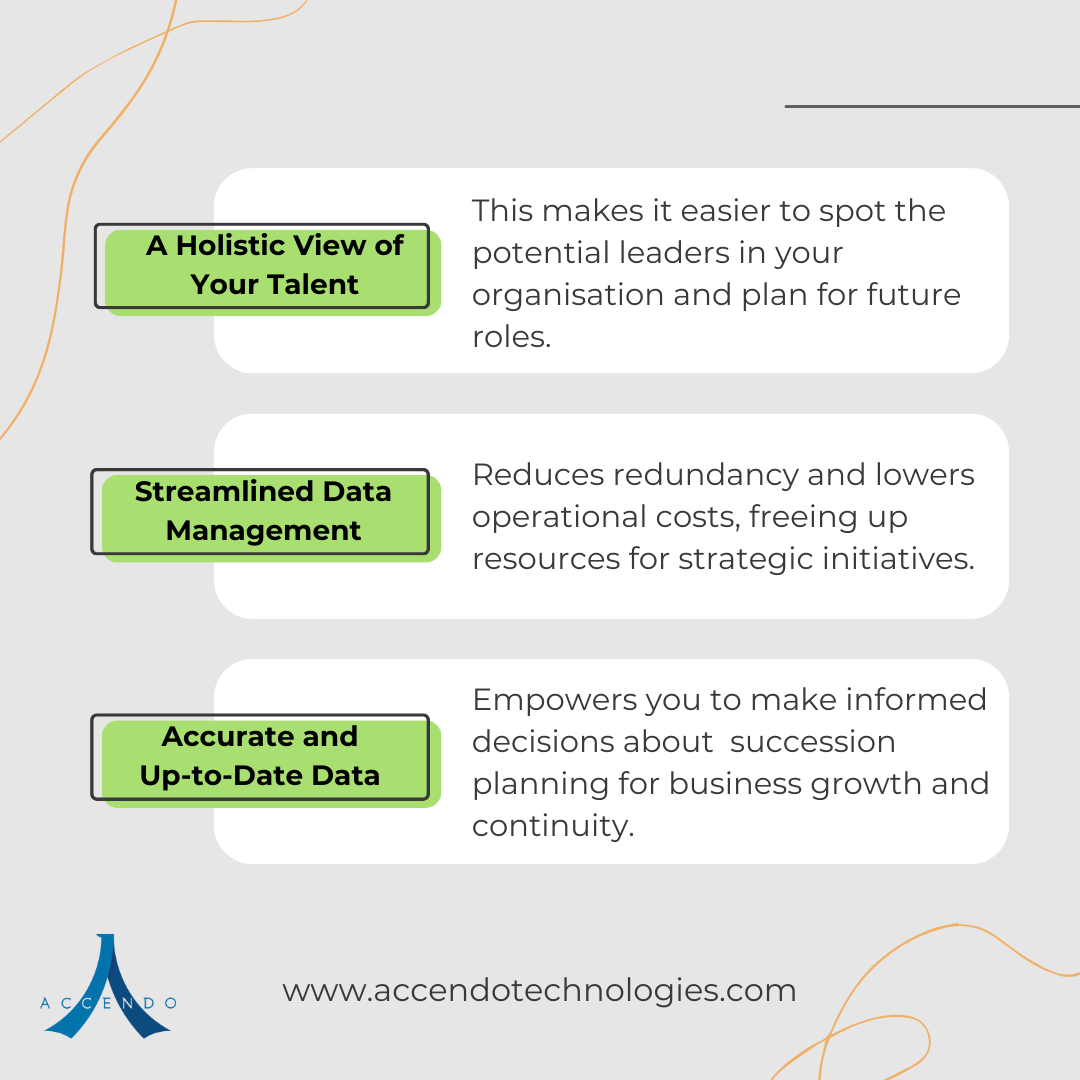Managing talent data from multiple sources can be a headache. Data consolidation can help by pulling all the scattered talent data into one neat, accessible place. Our article dives into the chaos of fragmented data. At the same time, we will explain how consolidating that data can simplify management, enhance decision-making, and improve your succession planning. By getting your data act together, you can streamline operations, make smarter choices, and set your organisation up for long-term success.
Key Takeaways
- Highlight the importance of data consolidation in succession planning.
- Improve data quality, streamline data management, and enhance decision-making.
- Learn how to leverage data consolidation for succession planning.
- How Accendo Technologies can help with data consolidation.
The Need for Data Consolidation in Succession Planning
Talent management processes like succession planning require a complete set of talent data. This includes performance metrics, feedback, psychometric tests, career aspirations, engagement scores, tenure, and experience.
HR teams are under pressure to make faster, more efficient, and higher-quality decisions about who should move into leadership roles. The key to all this? Ensuring the right person is matched to the right role at the right time.
But here is the catch – all this valuable data is often scattered across different systems and documents. This makes effective talent management a challenge for many companies.
Use Cases and Failure Points
Data is king. McKinsey predicts that by 2025, every aspect of work will be optimised by data.
Companies that are already making 20% of their profits from AI are much more likely to use data practices that lead to these impressive results.
QuantumBlack AI by McKinsey
But data only works its magic when it is integrated and unified. Scattered data makes it tough to extract insights and make informed decisions, leading HR teams to waste time and resources compiling data manually.

Before we explore data consolidation as a solution, we will talk about the headaches caused by scattered data. We will also highlight the weak spots in the process.
Why Scattered Data is a Big Problem
Organisations today juggle vast amounts of talent data spread across different platforms like CRMs, ERPs, and HRMS systems. All this scattered data makes it tough to get a clear picture and effectively manage talent, especially for succession planning.
It becomes a challenge for organisations to connect the dots. If these data points are not consolidated, the interpretation is left to manual intervention, often slow and inaccurate. Inefficiencies and missed opportunities occur, leading to difficulties in making informed decisions.
What Happens When Talent Data is Scattered
Dealing with scattered talent data is not just a minor inconvenience; it is a major headache that brings several complications:

- Data Silos: Different departments often use their own systems, creating isolated data pools that do not talk to each other. This makes it impossible to get a unified view of all your talent data.
- Inconsistent Data: When data comes from various sources, it usually comes in different formats. Trying to consolidate and analyse this mishmash of information is data a challenge.
- Time and Resource Intensive: Manually pulling together data from different systems is not only time-consuming but also prone to errors. This can undermine the reliability of your insights and decision-making processes.
- Security Risks: The more scattered your data, the higher the risk of security breaches and data loss. Multiple data points mean more opportunities for something to go wrong.
In short, scattered data makes it hard to get clear insights, wastes time and resources, and increases security risks. It is a big obstacle to effective talent management and succession planning.
Resolving Scattered Data with Data Consolidation
Data consolidation means bringing data together from various sources into a single, unified system. This allows users to engage data from a single point of access and fosters the generation of data insights.
Accendo Technologies’ TalentPulse is a prime example of effective data consolidation. It brings your talent data together, including performance metrics, psychometric assessments, and engagement scores, into a single system. It offers advanced analytics and reporting tools for a comprehensive view of your organisation’s talent.
Additionally, TalentPulse’s user-friendly interface simplifies the data management process, reducing time and resource burdens. By centralising data, TalentPulse reduces human error, streamlines workflows, and ensures real-time data processing. This leads to more reliable and timely insights, crucial for effective succession planning.

Leveraging data consolidation through tools like TalentPulse enables organisations to overcome the challenges of scattered data. This enhancement boosts their talent management and succession planning efforts.
Conclusion
Data consolidation is essential for modern businesses struggling with scattered talent data. By integrating all your data into one accessible place, you can streamline operations, enhance decision-making, and make succession planning a breeze. Tools like Accendo’s TalentPulse make this process even easier, offering a unified view of your talent, reducing redundancy, and improving efficiency. Get your data act together and set your organisation up for long-term success with reliable, timely insights and a solid strategy for the future.
Page Contents






